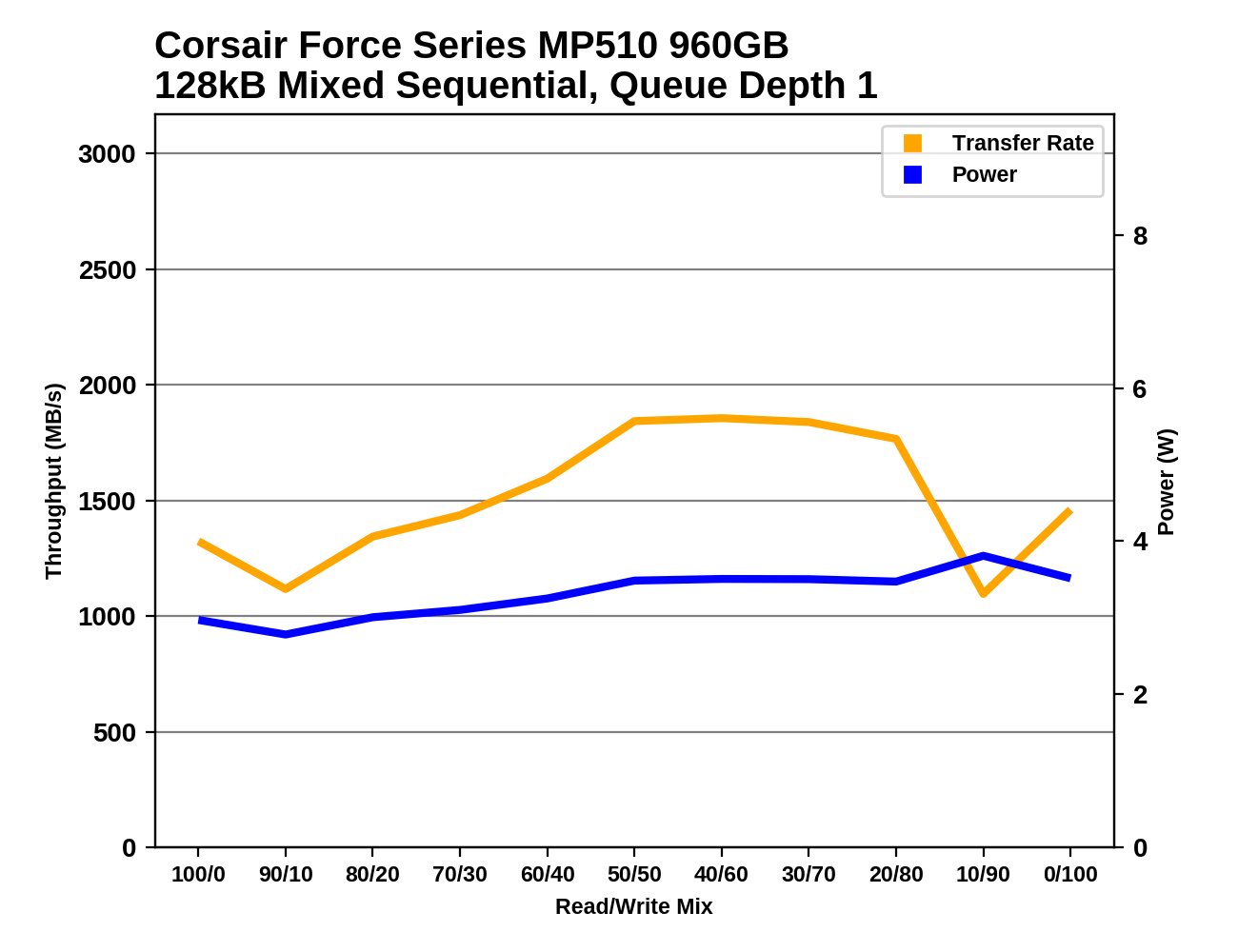The Corsair Force MP510 SSD (960GB) Review: A High-End Contender
by Billy Tallis on October 18, 2018 10:00 AM ESTMixed Random Performance
Our test of mixed random reads and writes covers mixes varying from pure reads to pure writes at 10% increments. Each mix is tested for up to 1 minute or 32GB of data transferred. The test is conducted with a queue depth of 4, and is limited to a 64GB span of the drive. In between each mix, the drive is given idle time of up to one minute so that the overall duty cycle is 50%.

The Corsair Force MP510 demonstrated above average random read performance and top tier random writes, but the mixed workload results are average at best. The WD Black averages about 18% higher performance with the same NAND, and the Samsung 970 EVO is about 40% faster.
 |
|||||||||
| Power Efficiency in MB/s/W | Average Power in W | ||||||||
As with performance, the power efficiency score from the MP510 is acceptable but nothing special compared to the Toshiba XG6 and WD Black.
 |
|||||||||
The unimpressive overall score from the MP510 on the mixed random I/O test seems to primarily stem from how it behaves during the more write-heavy half of the test. As the proportion of writes grows, the performance of the MP510 increases relatively slowly until the very end when performance spikes on the 100% cachable pure random write phase of the test.
Mixed Sequential Performance
Our test of mixed sequential reads and writes differs from the mixed random I/O test by performing 128kB sequential accesses rather than 4kB accesses at random locations, and the sequential test is conducted at queue depth 1. The range of mixes tested is the same, and the timing and limits on data transfers are also the same as above.

The Corsair Force MP510 provides excellent performance on our mixed sequential I/O test, but for once appears to be slightly slower than the Phison E12 engineering sample we tested earlier this year.
 |
|||||||||
| Power Efficiency in MB/s/W | Average Power in W | ||||||||
The MP510 turns in an extremely good power efficiency score for the mixed sequential I/O test: only about 4% behind the class-leading WD Black, and 50% better than the HP EX920.
 |
|||||||||
The performance curve of the Corsair Force MP510 on the mixed sequential I/O test looks rather unusual, with performance jumping around a bit and at its best during the more write-heavy half of the test. Most drives show a more typical bathtub curve with the best performance at either end of the test, but the WD Black's behavior does show similarities to the MP510.










42 Comments
View All Comments
leexgx - Thursday, October 18, 2018 - link
be nice if they do a renew on it as from unreliable source that did a review (toms hard) seems to find the P1 is only a little faster then a MX500 (yes the P1 its a NVME ssd but that's only good for sequential test it seems)yoyomah20 - Thursday, October 18, 2018 - link
I've been waiting for this review to come out. I'm excited about what corsair has put out, seems like its a pretty good competetor to 970 EVO and WD Black at a cheaper price point. I've been waiting for a power efficient nvme drive to replace my laptop's stock 128GB sata m.2 drive and I think that this is the one! Too bad it's not available anywhere yet...G3TG0T - Thursday, October 18, 2018 - link
Somehow the price SHOT up by double...G3TG0T - Thursday, October 18, 2018 - link
Who would buy that for double the price when you could get an EVO 970??!lilmoe - Thursday, October 18, 2018 - link
Damn Amazon and their sketchy crap. Go to newegg, the price is slightly up 10% though.Lolimaster - Thursday, October 18, 2018 - link
The other thing is using Office 365 Home, 6TB for $99 a year.shabby - Thursday, October 18, 2018 - link
Would be nice if all sizes were tested and not just the fastest, you guys should tell oems to send your all the sizes to test.leexgx - Thursday, October 18, 2018 - link
i could imagine that would take some time to test them, as i would guess Billy/reviewer runs the tests at least 2-3 times to make sure the results are consistent (not looked at the article yet but i guess it was the 1TB one they reviewed)WatcherCK - Thursday, October 18, 2018 - link
Do OSS NAS solutions (OMV/FreeNAS/Ubuntu+ZOL...) support fast/slow storage tiers transparently? I guess this would look like monolithic storage with the OS caching higher use files behind the scenes... hmmm, how hard would it be to have a hybrid drive that makes use of TLC/QLC (not in a fast caching scenario but say 512GB of TLC and 4/6/8TB QLC in one enclosure and a controller that can present both storage arrays transperently to the OS, an SSD only version of a fusion drive for example.)And agree with other posters about capacity, once 96 layer becomes ubiquitous then SSDs should be able to reach parity with mechanical HDD in terms of density and price as far as non enterprise users are concerned...
Wolfclaw - Friday, October 19, 2018 - link
Not fussed about top end speed, just cheap mass storage in raid or Microsoft Storage, that wipes the floor with HDD's and can satuate a SATA3 interface is more than enough for me.